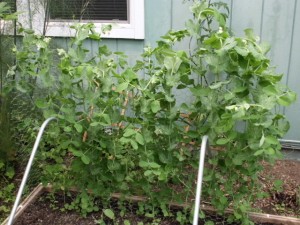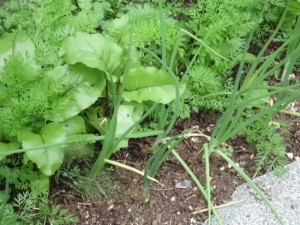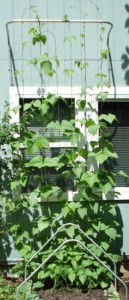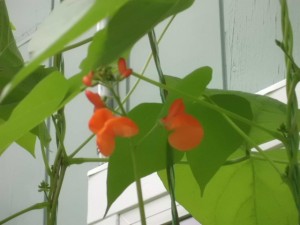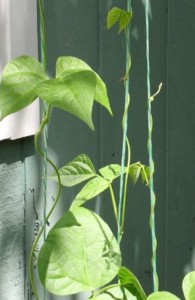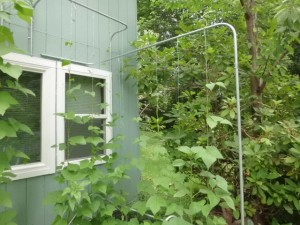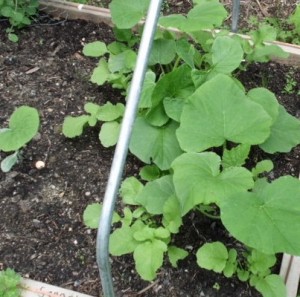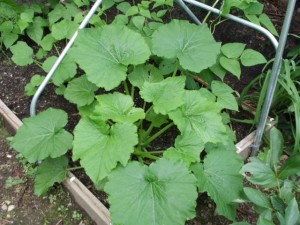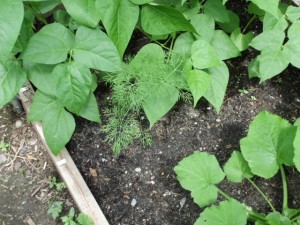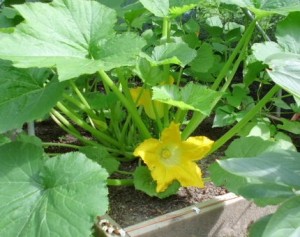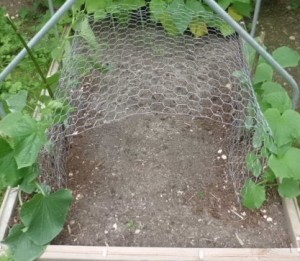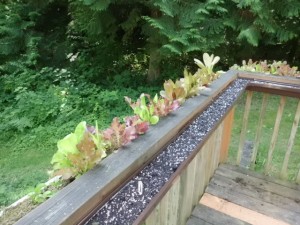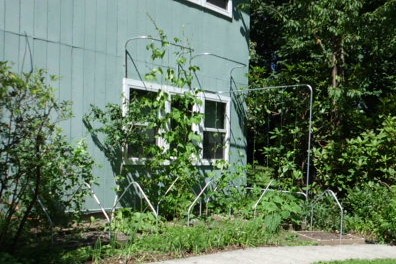 It’s been almost two months since I planted my flowerbed turned vegetable garden and I thought it was about time for an update so you could see how it’s growing. It’s doing just okay because we have experienced a wetter than normal summer so far, and I have struggled with slugs. Ugh! They have munched on my butternut squash, cucumbers and zucchini. I was able to save the zucchini, but had to replant the butternut squash and cucumbers. Since the second plantings came so late in the season, I am not sure I will be receiving much produce from them. We’ll see. The Scarlet Runner beans are going like gangbusters, and the peas are doing extremely well despite the late planting. Most likely the peas are doing well because of the mild temperatures this summer. I’m also very pleased with the Blue Lake beans.
It’s been almost two months since I planted my flowerbed turned vegetable garden and I thought it was about time for an update so you could see how it’s growing. It’s doing just okay because we have experienced a wetter than normal summer so far, and I have struggled with slugs. Ugh! They have munched on my butternut squash, cucumbers and zucchini. I was able to save the zucchini, but had to replant the butternut squash and cucumbers. Since the second plantings came so late in the season, I am not sure I will be receiving much produce from them. We’ll see. The Scarlet Runner beans are going like gangbusters, and the peas are doing extremely well despite the late planting. Most likely the peas are doing well because of the mild temperatures this summer. I’m also very pleased with the Blue Lake beans.
Some of you may be wondering what those metal frames are over the beds. My dear husband is an electrician and bends conduit for a living. When I asked him for hoops, he asked if I thought a straighter structure might work better and give the plants more room along the sides of the beds. Well, I had no idea if this would work because I had never seen such a thing before, but I thought it would be fun to experiment. I’ll let you know if they work in the winter when I plan to extend the growing season by covering the “hoops” with plastic.
Here are some close up shots of the garden:
The peas are climbing chicken wire that we shaped into “S” curves and attached to the conduit. This was a suggestion from the book Great Garden Companions: A Companion-Planting System for a Beautiful, Chemical-Free Vegetable Garden. When I planted them, the seed packet said the peas would grow to 28 inches. Um, the chicken wire is 3 feet high and it’s growing over the top. The only problem with them getting so tall is that the chicken wire is not strong enough to stay upright, and it is starting to fall over. When my husband got home from work today, I asked if he could fix it. He went out to take a look, came back upstairs and said, “I con-du-it.” It took me about 15 seconds before I groaned.
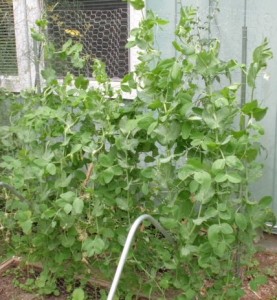 Here’s what it looks like after he used conduit stakes and added another foot of chicken wire to the top.
Here’s what it looks like after he used conduit stakes and added another foot of chicken wire to the top.
The carrots and beets are doing well, but I’m a little stumped by the performance of the onions, which is inconsistent even though they are well-mulched, fertilized and weeded. Onions can be picky, which is probably why I haven’t tried growing them before. We’ll see how they do by the end of the growing season. I will probably use the smaller ones like green onions or replant them for a spring harvest.
The Scarlet Runner beans are new to me this year, but I have heard they are big in the UK, which has a very similar climate to the Pacific Northwest here in the US. My dear husband constructed and attached the frame above the window so they would climb the string he attached to the frame. We are definitely going to have to use a ladder to harvest these beans!
These babies are doing fabulous, and the flower is a beautiful red color!
The Blue Lake pole beans needed a second planting due to inconsistent germination, but otherwise are doing very well. You can see they love being supported by this string! My husband was surprised at how both types of pole beans seemed to hug the string virtually overnight.
These beans were planted in an “L” shape in the bed, and he is responsible for designing the cool frame you see in the above picture.
After fighting with the snails, slugs, cutworms and possibly birds, these three Butternut Squash plants made it through unscathed. I planted six hills altogether, though. I’m praying these continue to do well and it’s not too late in the year to get a decent harvest. I fell in love with butternut squash this year and am hoping to save some money by growing my own. I interplanted radishes to help with squash bugs and found they also helped protect the seedlings from slugs. Bonus!
The zucchini is also looking very good! There are two plants in this hill and a smaller one to the left. I found several small zucchinis throughout these plants, so a good harvest looks promising!
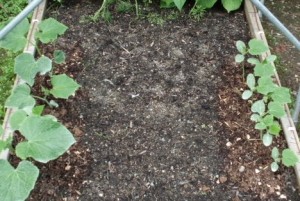 The cucumbers also needed two plantings as you can tell from this picture. The plan is to construct a half circle out of chicken wire and train the cucumber plants over the top. It is supposed to create dappled shade during the heat of summer for lettuce that could be planted beneath. I have no idea if it will work, but it was also a suggestion in the book Great Garden Companions
The cucumbers also needed two plantings as you can tell from this picture. The plan is to construct a half circle out of chicken wire and train the cucumber plants over the top. It is supposed to create dappled shade during the heat of summer for lettuce that could be planted beneath. I have no idea if it will work, but it was also a suggestion in the book Great Garden Companions so we thought we would give it a try. I am extremely pleased to see some tiny cucumbers on the larger plants and am looking forward to making pickles!
Dill is supposed to be beneficial for beans, and they are doing fairly well. I add dill to my broths and soups for a mineral boost. It is also very good with fish and salads. I sometimes add dill to my chicken’s nests because it is a natural relaxant and provides respiratory health.
Here are two more pictures I took a few days later:
I started harvesting the peas last night, and we had some for dinner. They were delicious! I also added some dill and pea shoots to our mesclun salad. The mesclun lettuce is on our back deck. I planted it in my Stack and Grow and in rain gutters that we attached to our deck rails. I’ll share how we did this in my next post. Here’s a picture so you can see what I’m talking about:
I hope you have enjoyed this update. I plan to continue these updates so you can see how my garden grows. Hopefully, this will give you some inspiration. 🙂 God bless your gardens!
Do you have a garden? How does your garden grow? Are you enjoying a harvest? If you don’t have a garden, do you want one? I’m passionate about gardening and can help you learn how to grow something no matter where you live. Please leave me a note in the comments.
Some of my links are affiliate links and help support this blog. Your privacy is important to me, and I do not sell email addresses.
Shared on The Morristribe’s Homesteader Blog Carnival and Homestead Barn Hop.

